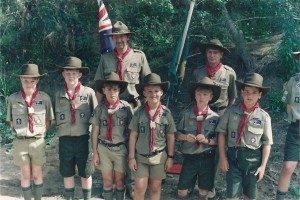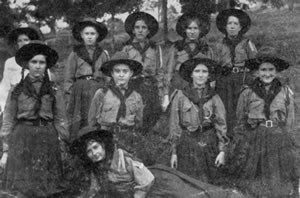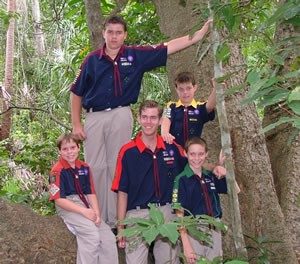Scouts in Queensland
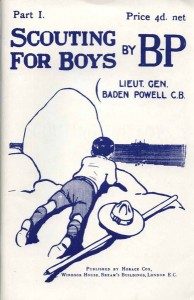 History of Scouting in Queensland
History of Scouting in Queensland
On 15th January 1908 the first of a six-part publication, issued fortnightly, was published in England. This now famous publication was Scouting for Boys and was written by Robert Stephenson Smythe Baden-Powell. This book was written by Baden-Powell to formalise his theories for training the boys of Britain. He had tried out his ideas on a group of twenty boys at an experimental camp on Brownsea Island, Poole Harbour, Dorset, from 25th July to 9th August 1907, and they were met with great success.
Almost immediately, boys throughout England began to form Patrols, and very soon after the publication of the booklets, Scouting began in Australia. Scouting came to Queensland in Augu
st 1908, when four young men started Patrols of Scouts. They were Charles Smethurst Snow (Kangaroo Point), Lesleigh John Williams (Bowen Hills, later New Farm), Leonard Lovejoy (Ashgrove) and Septimus Davies (Toowong). All men were involved in boys’ clubs or Sunday Schools at their local church, and the members of the first Patrols came from these groups. In the beginning, these four men operated their Patrols in isolation, but in 1909 came together to establish a State organisation.
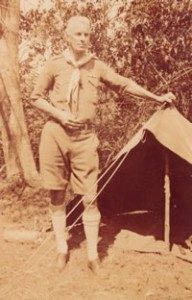
Charles S Snow
Scouting spread rapidly throughout Brisbane and the provincial towns and rural areas of Queensland. Some of the early Patrols were formed at Ithaca, Windsor, Nundah, Townsville, Boonah, Gympie and Nambour. During this time, Chief Scoutmaster Snow formed the “Chief Scoutmaster’s Own Patrol” (C.S.O) which met at his home on Shafston Avenue, Kangaroo Point. On 20th July 1910, a letter wa
s sent by the Australian League of Boy Scouts, Queensland Section, to Boy Scout Headquarters London, stating that “they are desirous of affiliating with the Home Headquarters.” The letter goes on to say that “the Council was formed in October 1909……so far as can be ascertained the Council have 45 Troops and 950 Scouts”. On 2nd July 1910 a letter was sent from Boy Scout Headquarters London to Septimus Davies stating “the Headquarters Council have great pleasure in affiliating your Council with the Home Headquarters. The names of the Council will be duly gazetted”. The name of the movement in Queensland was changed to “League of Baden-Powell Scouts, Queensland Section”.
On 13th September 1910, a formal constitution was adopted and printed. This provided regulations for the conduct of Scout Troops, uniform to be worn, qualifications of the Scoutmasters and such like matters. Charles S Snow was the first Chief Scoutmaster (now Commissioner). King George V arranged a prize of a silk Union Jack on which was the Royal Crown and the Scout Badge for the Scout Troop with no less than 24 members, who had the greatest number of King Scouts by 30thSeptember 1911. This honour went to the 1st Gympie Troop, who had the most King Scouts of any Troop in Australia.
“Divisions” and “Districts” made their appearance as early as 1910, but these were not formalized until the mid 1920s. Queensland adopted the “Group” system on 15th October 1928 – sections and Leaders of a particular locale became a Group, however it took to the 1930s for this system to be implemented. By 1960 there were 330 Groups in Queensland and by 1985 this had increased to 409. In 1964, the number designation of a Group was dropped e.g. 1st Wavell Heights became simply Wavell Heights. If there was more than one Group in the locality, then a local historical or Indigenous name was used, although some Groups retained their number. The original Group nametapes were red lettering on white tape. This changed in 1968 to gold lettering on bottle green tape and in 2004 they again changed to be gold lettering on maroon tape. By the 1960, District nametapes worn on the shoulder had changed to District Badges worn above the right pocket.
Major changes happened in 1972 in response to the recommendations of the Design for Tomorrow Committee. Among the changes, the Australian Boy Scouts Association became the Scout Association of Australia. Uniforms changed – no sock tops, garter tabs or metal buttons. Cubs now wore a green hat with yellow band and khaki uniforms replaced the gray and navy blue. The Promise and Law also changed, and the World Badge became the Membership Badge, replacing the Tenderfoot Badge for Scouts, Venturers and Rovers and the Tenderpad Badge for Cubs. Wolf Cubs became Cubs, but the ages stayed basically the same. Boomerang tests at 3 levels replaced the “Eyes”. Link Badges were introduced to facilitate the transition from one Section to the next. A new Award Scheme for Scouts was introduced in 1973, with Pioneer, Explorer and Adventurer Target Badges replacing the Second Class and First Class badges. The Scoutcraft Badge was introduced in 1979 to teach basic Scouting skills that had become lost and was a precursor to doing the Target badges. The Venturer Award Scheme now consisted of two badges, Venturer Award and Queen’s Scout Award, with a third badge – Major Interest – for those with a specialised interest. In 1977 a new Award Scheme was introduced for Rovers with the Baden-Powell Award becoming the pinnacle of the section.
Girls In Scouts
In 1919, some girls wanting to be Girl Scouts approached Miss Marjorie Grimes of Tarragindi. She formed a Troop with the help of Scoutmaster Alan B Cribb of 1st Ipswich. As had happened in England, girls in Scouts met with disapproval and it was eventually suggested that they become Girl Guides. The Tarragindi Girl Scouts became Queensland’s first Girl Guides on 20th April 1920.
These intrepid girls, however, were not the first girls in Queensland to try Scouting. The League of Girl Aids began in March 1910. They wore the Scout uniform with a skirt and their handbook was “Scouting for Boys”. It would not be until 1975 that girls were allowed to be Rovers. Despite much opposition to young ladies joining Rovers, a trial Rover Crew was set up at Baden-Powell Park, Samford, and attached to Branch Headquarters. The girls eventually joined pre-existing Crews.
Scouting admitted girls and young women to its Venturer Scout and Rover Scout Sections in 1975 and its Cub Scout and Scout Sections in 1988.
The next major change was the introduction of the Joey Scout section in 1990. It is believed that he first Joey Scout Mob for boys and girls aged six and seven started operation on 1st October 1990 at Wavell Heights. Along with the introduction of Joey Scouts, girls could be admitted to all Sections without the need for the approval of the Group and Branch Headquarters. Although the Joey Scout Section was deemed by some of the diehard Scout Leaders as a kindergarten or baby-sitting service, the Section soon flourished with Mobs being formed throughout Queensland. Some of those original Joey Scouts have progressed through the movement and are now Adult Members.
In 2004, the Scout uniform changed again moving to a new navy uniform to replace the traditional khaki, which caused quite a controversy. The new uniform was voted on by all the States and Territories and the move was seen as a way of modernising the movement, getting away from the military look and, hopefully, attracting new members.
This is a journey that has taken over 100 years and is still evolving. There have been many changes along the way, the introduction of new Sections, changes in uniforms and Award Schemes. Despite all the changes, this journey still carries on the Aim of the Scout Movement and the principles as identified by our Founder, Lord Baden-Powell, that man should serve God, act in consideration of the needs of others and use his abilities to the betterment of himself, his family and the community in which he lives.

